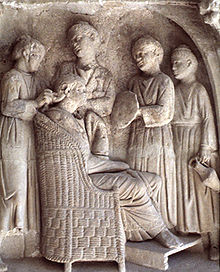Egypt Greece and Rome The beginning Part I
It all began 6000 years ago, and almost every society on Earth has had a part in it and has challenged and reformed the way we view, apply, and research Makeup today.
Makeup was used by both Men and Women in Egypt.
The Egyptians were known for painting their lips either vibrant shade of red or a kind of bluey-black colour.
They also used eyeliner, colors varied when it came to eyeliner, green was used in the time of the Old Kingdom whereas black came into vogue during the New Kingdom era. The green eyeliner was made of green malachite which was found in Sinai, or green copper ore. The black eyeliner was made from a lead sulfide called Galena and came from Gebel-et-Zeit in the desert. Later on, Kohl came to be used which was a fun mix of soot and galena. Until today, this process is pretty much the same as in Egypt for application of Khol- which is basically the same stuff the ancients used. The daily routine with Kohl was used to outline and enhance the eyes and brows, Kohl was applied liberally to the lids, browbone and lower lash line. It was believed that eye makeup could ward off evil spirits and improve sight.
Blush was also used, it was made from red Ochre which was a clay that was naturally tinted. Henna was also popular both for nails and hair.
Unfortunately, many of these cosmetics were potentially dangerous and/or deadly.
Applying the makeup would have been quite a lot of work, It wouldn't have been in small containers like today. They would have had large surfaces with various tools and instruments used to crush and mix things, depending on rank and wealth, tools could range from simple leather pouches and sticks to embellished and bejeweled containers and applicators.
First they would have to grind up their cosmetics and then mix it with fat or water so that it would glide readily on to the skin. Once the makeup was prepared, a wand or stick made of ivory, wood or bone would have been used to apply it.
Ancient Greece:
Cosmetics were an important part of the life and culture of the Ancient Greeks.
Their idea of beauty was pale skin, golden locks and natural makeup and, just like it happens nowadays, they would try everything to achieve it. However, only rich women used makeup in Ancient Greece, which was probably due to it's expensive price.
To lighten their complexions, women would paint their faces with white lead, which was toxic and probably shortened their lives. The alternative to lead was chalk, but that came off easily and quickly. Their lipstick was a paste made with red iron oxide and Ochre clay or olive oil with beeswax. A red powder was also used on the cheeks. Eyeshadows were made with olive oil mixed with ground charcoal. Also, the Ancient Greeks liked connected eyebrows and to achieve this they would decorate their eyes with dark powder.They would take care of their skin by moisturizing it with honey. Olive oil was also used to make their skin shiny.
The Roman Empire:
Roman attitudes towards cosmetics evolved with the expansion of the empire. The assortment of cosmetics available increased as trade borders expanded, Ideas of beauty from conquered peoples especially the Greeks and Egyptians, greatly influenced the Roman paradigm of beauty.
Although Romans esteemed pale faces (much like the Greeks) a light pink on the cheeks was considered attractive, signifying good health, sources of Rouge included Tyrain vermillion, rose and poppy petals, focus, red chalk, alkante, and crocodile dung. Red Ochre, a more expensive blush, was imported from Belgium and ground against a stone into powder. Despite a widespread knowledge that cinnabar and red lead were poisonous (and still are to this day), they were both still used extensively. Cheap alternatives include mulberry juice and wine dregs.
The ideal eyes, from a Roman perspective were large with long eyelashes. Kohl was the main ingredient in eye makeup, and was composed of ash or soot and antimony (an element), with saffron usually added to improve the smell. Kohl was applied using a rounded stick made of ivory, glass, bone, or wood that would be dipped in either oil or water first, before being used to apply the kohl. Charred rose petals and date stones could be used to darken the eyes also.
Green eye-shadow came from poisonous malachite (a copper carbonate hydroxide mineral), while blue came from azurite (a deep copper mineral).
The Romans preferred dark eyebrows that almost meet in the center (just like the Greeks), This was achieved by darkening their eyebrows with antimony or soot and then extending them inward. Plucking began in the 1st century BC to tidy their overall look.
Although evidence for the usage of lipstick appears in earlier civilizations, no such evidence has materialized to indicate that the Romans ever used colours on their lips.
to be continued..





No comments:
Post a Comment